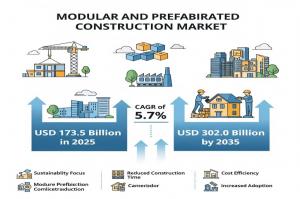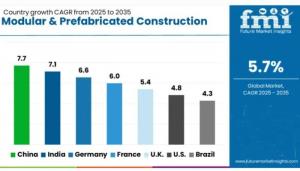Modular & Prefabricated Construction Market to Reach USD 302.0 Billion by 2035: A Transformative Era for Manufacturers
The UK modular market grows 5.4%, driven by housing demand, fast builds, 3D printing, composites, and rising use in classrooms & healthcare.
NEWARK, DE, UNITED STATES, August 21, 2025 /EINPresswire.com/ -- The modular and prefabricated construction market is entering a decade of rapid transformation, offering manufacturers opportunities to lead innovation, improve efficiency, and deliver scalable solutions for the future of global infrastructure. Estimated at USD 173.5 billion in 2025, the market is forecast to expand to USD 302.0 billion by 2035, recording a CAGR of 5.7% over the period.
From 2025 to 2030 alone, steady growth will see the industry rise from USD 173.5 billion to USD 228.9 billion, underscoring the increasing reliance on modular and prefabricated methods across residential, commercial, and industrial projects. This momentum signals a shift in how the construction industry addresses challenges such as labor shortages, cost pressures, and sustainability demands.
Unlocking Efficiency and Scale for Manufacturers
The market’s strength lies in its ability to cut project timelines, minimize labor costs, and ensure consistent quality through factory-controlled environments. By 2026, values are projected at USD 183.4 billion, rising steadily to USD 193.9 billion in 2027 and USD 204.9 billion in 2028, as adoption accelerates.
Manufacturers are increasingly central to this shift, supplying modular components that not only reduce waste but also deliver sustainable, repeatable designs at scale. With governments pushing affordable housing and eco-friendly building policies, manufacturers equipped to provide energy-efficient, compliant, and customizable modules are poised for long-term success.
Key Market Takeaways
• Market Value 2025: USD 173.5 billion
• Forecast 2035: USD 302.0 billion
• CAGR (2025–2035): 5.7%
• Leading Segment 2025: Permanent modular (61.3%)
• Top Regions: North America, Asia-Pacific, Europe
• Notable Players: Skanska, ACS Group, Algeco (Modulaire Group), Berkeley Modular Limited, Bouygues Construction, DUBOX, Hickory Group, Kiewit Corporation, Larsen & Toubro Limited, VINCI Construction, among others
Why Manufacturers are Driving Market Growth
The sector accounts for 6–8% of the global construction industry and nearly 65% of the offsite construction market, proving its growing role in reshaping industry norms. Demand is reinforced by:
• Affordable housing initiatives in urban areas
• Rapid deployment needs in healthcare and disaster-prone regions
• Green-certified structures addressing sustainability goals
• Digital integration through BIM and automation
For manufacturers, this translates into opportunities to lead the shift toward standardized yet customizable building designs while addressing the global housing and infrastructure gap.
Segment Insights: Where Opportunities Lie
Permanent Modular Construction
The permanent modular segment will command 61.3% of revenues in 2025, reflecting growing trust in modular systems as durable, code-compliant alternatives to traditional builds. Manufacturers producing permanent systems benefit from repeatable designs, cost savings, and energy efficiency compliance, making this the most stable growth avenue.
Steel Dominance
By material, steel will account for 47.8% of the market in 2025. With unmatched strength-to-weight ratios, durability, and recyclability, steel’s compatibility with prefabrication methods ensures it remains the go-to choice for high-rise and complex modular applications. Manufacturers investing in advanced steel fabrication and finishing technologies stand to strengthen their market position.
Multi-Family Residential
Accounting for 33.6% of revenue in 2025, the multi-family residential segment is set to lead application areas. Growing demand for affordable, high-density housing is pushing developers toward modular solutions. Manufacturers offering scalable, sustainable, and cost-efficient systems are at the forefront of solving one of the world’s most pressing challenges: urban housing shortages.
Drivers and Challenges Manufacturers Must Address
• Project Time Optimization: Real estate and government-backed housing programs demand faster delivery, making pre-engineered, structurally reliable modules highly sought after.
• Hybrid Modular Systems: Combining steel, concrete, and composite materials is creating opportunities for high-rise, mixed-use projects, offering manufacturers new avenues in premium urban construction.
• Logistical Complexities: Transportation and assembly challenges remain barriers, particularly oversized modules requiring special permits. Manufacturers that streamline logistics will gain a competitive edge.
• Hybrid Construction Techniques: Blending prefabrication with on-site customization is enhancing design flexibility, opening premium market segments once resistant to prefabrication.
Regional Growth Outlook
• China (CAGR 7.7%): Massive urbanization and government mandates are propelling prefabricated steel and concrete units, with manufacturers integrating smart components for faster deployment.
• India (CAGR 7.1%): Affordable housing programs and rising healthcare demand drive modular growth, positioning manufacturers as key enablers of cost-effective, eco-compliant projects.
• Germany (CAGR 6.6%): Focus on sustainability and adoption of CLT modular systems creates opportunities for eco-material manufacturers and automation leaders.
• France (CAGR 6.0%): Lightweight and hybrid modular systems dominate compact urban markets, supported by government incentives for energy efficiency.
• United Kingdom (CAGR 5.4%): Affordable housing shortages and urban redevelopment are pushing demand for plug-and-play modular units, strengthened by innovations in 3D printing.
Request Modular & Prefabricated Construction Market Draft Report:
https://www.futuremarketinsights.com/reports/sample/rep-gb-23063
For more on their methodology and market coverage, visit https://www.futuremarketinsights.com/about-us.
Competitive Landscape: Manufacturers at the Center
The market remains moderately consolidated, with leaders like Skanska driving innovation through digital integration and sustainable construction models. Alongside Skanska, companies such as ACS Group, Bouygues Construction, Laing O’Rourke, Sekisui House, Ltd., VINCI Construction, and Larsen & Toubro Limited are leveraging automation, robotics, and hybrid methodologies to reduce waste and improve scalability.
For manufacturers, the clear path to success lies in off-site precision, faster assembly, and sustainable material integration. Those that align production with green standards, while offering design flexibility, will capture greater market share.
Related Insights from Future Market Insights (FMI)
Construction Sealants Market - https://www.futuremarketinsights.com/reports/construction-sealants-market
Modular Construction Market - https://www.futuremarketinsights.com/reports/modular-construction-market
Modular Chillers Market - https://www.futuremarketinsights.com/reports/modular-chillers-market
Construction Bots Market - https://www.futuremarketinsights.com/reports/construction-bots-market
Editor’s Note:
The Modular & Prefabricated Construction Market is transforming global building practices with faster, cost-effective, and sustainable solutions. Driven by urbanization and rising demand for efficiency, it is reshaping residential, commercial, and industrial projects. This growth signals a pivotal shift toward innovation and modern construction methods.
Rahul Singh
Future Market Insights Inc.
+1 347-918-3531
email us here
Legal Disclaimer:
EIN Presswire provides this news content "as is" without warranty of any kind. We do not accept any responsibility or liability for the accuracy, content, images, videos, licenses, completeness, legality, or reliability of the information contained in this article. If you have any complaints or copyright issues related to this article, kindly contact the author above.
Mobility Aid Medical Device Industry Analysis Report 2025: Key Trends, Drivers, and Forecast Insights
Lancet Market Set to Reach $4.25 Billion by 2029
Medicated Skincare Market - Opportunities, Share, Growth and Competitive Analysis and Forecast 2029
Więcej ważnych informacji
 Jedynka Newserii
Jedynka Newserii

 Jedynka Newserii
Jedynka Newserii

Finanse

K. Gawkowski: Polska w cyfrowej transformacji gospodarki awansowała do pierwszej ligi w Europie. 2,8 mld zł z KPO jeszcze ten proces przyspieszy
Uruchomiony na początku lipca przez Ministerstwo Cyfryzacji i BGK program „KPO: Pożyczka na cyfryzację” cieszy się dużym zainteresowaniem. Samorządy, uczelnie oraz firmy mogą wnioskować o wsparcie finansowe dla inwestycji w transformację cyfrową, m.in. modernizację infrastruktury czy cyberbezpieczeństwo. W sumie na ten cel trafi 2,8 mld zł (650 mln euro). Ze względu na krótki czas naboru obie instytucje organizują w poszczególnych województwach warsztaty dla wnioskodawców, które mają rozwiać ich wątpliwości przy przygotowywaniu wniosków.
Prawo
Koszty certyfikacji wyrobów medycznych sięgają milionów euro. Pacjenci mogą stracić dostęp do wyrobów ratujących życie

Od 2027 roku wszystkie firmy produkujące wyroby medyczne w Unii Europejskiej będą musiały posiadać certyfikat zgodności z rozporządzeniem MDR (Medical Devices Regulation). Nowe przepisy wprowadzają dużo ostrzejsze wymagania w zakresie dokumentacji, badań klinicznych oraz procedur certyfikacyjnych. Branża ostrzega, że część małych i średnich producentów nie zdąży się dostosować. Problemem jest także wysoki koszt i długi czas uzyskiwania certyfikatów. W konsekwencji z rynku mogą zniknąć urządzenia ratujące życie.
Infrastruktura
Nowe przepisy o ochronie ludności cywilnej wprowadzają obowiązkowe elastyczne zbiorniki na wodę. Mają one służyć w razie suszy, pożarów czy wybuchu wojny

Samorządy będą musiały posiadać m.in. elastyczne zbiorniki na wodę pitną i przenośne magazyny wody przeciwpożarowej. To element odpowiedniego przygotowania zasobów na wypadek sytuacji kryzysowych, kataklizmów czy wybuchu konfliktu, wprowadzony nowymi przepisami o ochronie ludności. Eksperci podkreślają, że tego typu rozwiązania to innowacyjne produkty, które nie tylko ułatwiają logistykę w sytuacjach kryzysowych, ale także mogą znacząco skrócić czas reakcji służb ratunkowych.
Partner serwisu
Szkolenia

Akademia Newserii
Akademia Newserii to projekt, w ramach którego najlepsi polscy dziennikarze biznesowi, giełdowi oraz lifestylowi, a także szkoleniowcy z wieloletnim doświadczeniem dzielą się swoją wiedzą nt. pracy z mediami.









.gif)

 |
| |
| |
|